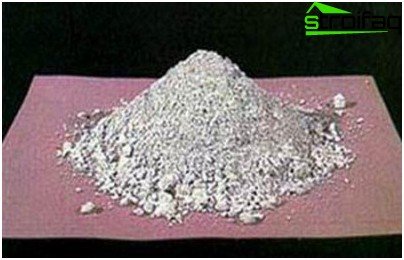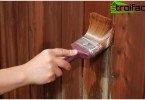In the fall, when the harvest has long been harvested, and multi-colored jars of jam and pickles adorn the shelves in the pantry, it’s time to worry about preparing the site. Properly organized care for fruit trees in the garden, as well as the autumn work of the greenhouse will be the key to a future rich harvest. For a successful “wintering” it is necessary to carry out a number of basic works, with the technology of each stage of which we propose to get acquainted in more detail.
Content
- Cleaning the “covered” area
- Greenhouse disinfection
- Wall washing frame construction
- Digging and fertilizing the soil
- Arrangement of props to strengthen the frame
Tips for autumn work in the greenhouse
Cleaning the “covered” area
Restoring order in the greenhouse can begin immediately after collecting the last harvest of the season. It is important to have time to carry out work before the onset of frost, as frozen ground becomes less soft and supple.
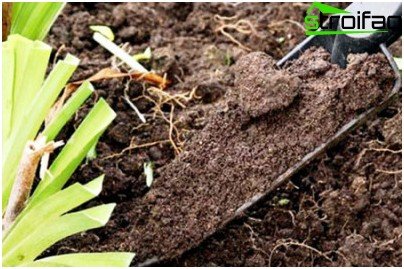
After harvesting, seeds, roots and aerial parts of plants always remain in the soil
Having collected large parts of plant debris, it is advisable to completely replace the topsoil. This will prevent the propagation of weeds inside the greenhouse next season. To do this, use a shovel to remove a layer of earth with a depth of 5-7 centimeters. You can use this land by using it when arranging beds for planting onions or garlic in open ground.
If the removed layer of the earth is affected by the disease or is “rich” in pests, it must be decontaminated by liming. To do this, lay the soil in layers on an open area in the garden and sprinkle with the calculation of 150 g of lime per 1 sq. Km. m of soil. Layers laid out in this way are left for the winter, and in the spring they are carefully shoveled and again used for arranging the beds.
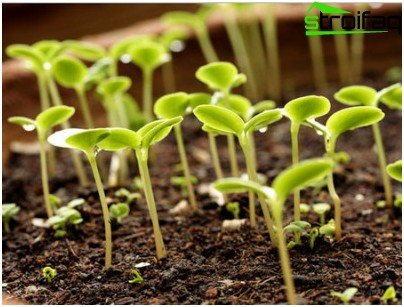
As a result, on cleaned areas in the greenhouse, you can pour out a new, clean and fertile soil, which will serve as the basis for the development of spring seedlings
If to clear the site of plant “garbage” is a simple task, then getting rid of harmful insects is a job that requires more effort. The larvae of the May beetle and wireworm, which took refuge under a layer of soil in anticipation of warming and new plantings, can cause a lot of trouble in the next season. These harmful insects prefer to live in dense soil. Therefore, the best way to get rid of them is to dig the beds, sowing the soil and manually selecting pests.
Greenhouse disinfection
Disinfection of the soil surface is carried out at a temperature of + 10 ° C, which is considered optimal to achieve the maximum effect. The annual cultivation of the land allows you to get rid of the prevailing pathogens of the soil.
Many gardeners use folk remedies to control pests. For tillage, they use infusions of plants with the ability to kill pathogens: tobacco, mustard, garlic.
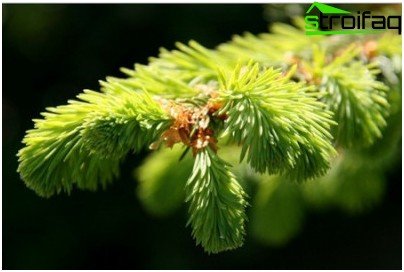
Quite often, for these purposes, they use coniferous extracts.
If we consider the means of control based on chemical components, then for the treatment of soil “ailments”, you can apply effective and proven over the years methods:
- Sulfur versus spider mite.
In the fight against this pest, as well as other bacterial infections and molds, fumigation of the room with sulfur or sulfur blocks gives a good result. The required amount of substance is taken with the expectation that 150 grams of powder is enough per 1 cubic meter. To increase the efficiency of the procedure, all frame elements of the greenhouse are carefully clogged, filling the cracks, and sprayed with water beforehand. Since the emitted gas is dangerous not only for the tick, but also for human health, fumigation of the structure should be carried out wearing protective equipment and a gas mask.
The powder is poured into small slides on metal sheets, which are laid along the inner walls of the greenhouse, and set on fire
Filling the greenhouse with sulfur fumes, it should be tightly closed and left for two to three days. After that, it is enough to ventilate the room and rinse the glass surfaces of the structure.
- Karbofos from the black leg.
For the procedure, the powder is diluted in water, taking 90 grams of powder per 10 liters of water. This volume of disinfectant solution is enough to process 1 cubic meter of soil. It is sprayed on the surface of the soil, and then the treated beds are dug up. A solution of this concentration can also be used in the fight against the gall nematode..
- Carbion from malicious keel
You can get rid of the keel, which brings considerable harm to green spaces, by treating the surface with a solution of carbation. To do this, you need to dilute 500 grams of powder in 10 liters of water. The diluted solution is sprayed on the surface, or evenly distributed using a watering can with a spray.
Wall washing frame construction
After any treatment using chemical agents, it is necessary to ventilate the room and wash the internal walls of the structure. Wall washing is best done in two stages: rinse the first time using any soapy solution, and the second time with clean water. You can wash the glass surfaces of the greenhouse using soda and mustard.
It is extremely undesirable, especially when working with polycarbonate, to use aggressive detergents and hard brushes that can only damage the inner surface of the walls.

When working with glass frames of the greenhouse, special attention should be paid to crevices and gaps, since they are the “breeding ground” of pest colonies
If the design is equipped with a film coating, which is removed from the frame at the end of the season, the film can be washed with soapy water even before removal. After that, it must be thoroughly dried and folded until spring in a warm, dry room.
The greenhouse frame is treated with a solution of bleach, diluting 400 grams of powder from a flow rate of 10 liters of water. The solution must be infused for at least 4 hours before use. The metal elements of the frame and pipes of the connection are poured with boiling water, and wooden slats – 10% with copper sulfate. The same solution can be used to process racks, containers for seedlings and garden tools.
Digging and fertilizing the soil
To fill the top layer of beds use a fertile layer of soil.
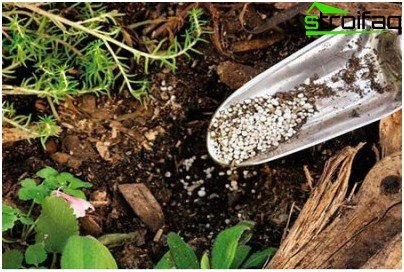
The fertile soil layers can be enriched by adding humus, manure or peat to their composition.
An average of 2 square meters of soil requires 1 bucket of natural fertilizer. It is distributed over the surface of the beds and dug up, buried on a bayonet shovel.
It is possible to enrich the soil using mineral fertilizers. Depending on the soil composition and the requirements for growing a particular crop, superphosphate or potassium sulfate is added to the soil in the required proportions. In the spring, snow “hats” will help to moisten the soil, which can be brought into the greenhouse even in winter and laid out in the beds.
Arrangement of props to strengthen the frame
Since the bearing capacity of most greenhouses does not exceed 500 kg / sq.m, and the mass of snowdrifts accumulating on the roof of the structure can reach about a ton, additional support of the structure must be provided. Some prefabricated models are equipped with special removable arcs that support the frame in winter.
Retaining structures are easy to make and most.
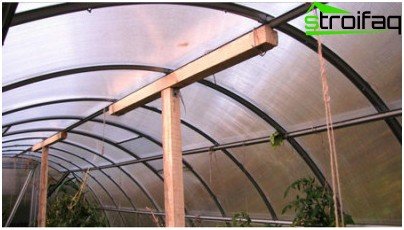
Outwardly, they resemble the capital letter “t”, the upper bar of which supports the top of the greenhouse
The number of supports depends on the size of the greenhouse: at least 3-4 supporting structures will be required to equip a greenhouse of 6 meters in length.
Having processed the walls of the greenhouse, enriched the soil composition and strengthened the roof and walls of the structure, you can be sure that now it is not afraid of either snow or winds, and the plants planted in spring will please with friendly shoots and a plentiful harvest.


